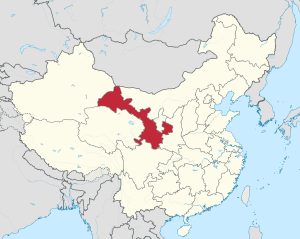Gansu facts for kids
Gansu is a large province in the People's Republic of China. Its capital city is Lanzhou, located in the southeastern part of the province. Gansu is known for its unique geography and long history.
The province covers a huge area of about 454,430 square kilometers. In 2018, around 26,257,000 people lived there. Most of the people in Gansu are Han Chinese.
Geography and Climate
Gansu has a very interesting landscape. The southern part of the province is mountainous, with tall peaks and valleys. As you move north, the land becomes flatter.
Part of the famous Gobi Desert stretches into Gansu. The mighty Yellow River also flows through the southern areas of the province. Interestingly, Gansu is home to the geographical center of China!
The climate in Gansu is dry and continental. This means it has cold winters with snow and ice, and hot summers.
Neighboring Regions
Gansu shares its borders with several other places. To the north, it touches the Govi-Altai Province in Mongolia. To the northeast, it borders Inner Mongolia.
To the east, you'll find Ningxia, and to the southeast is Shaanxi. Sichuan province is to the south. To the west, Gansu borders Qinghai, and to the northwest is Xinjiang.
Images for kids
-
The ruins of a Han dynasty (202 BC–220 AD) Chinese watchtower made of rammed earth at Dunhuang, Gansu province, the eastern edge of the Silk Road
-
The ruins of a gate at Yumen Pass, built during the Jin dynasty (266–420)
-
Lanzhou city
-
A painting of the Buddhist Manjushri, from the Yulin Caves of Gansu, Tangut-led Western Xia dynasty (1038–1227 AD)
-
These rammed earth ruins of a granary in Hecang Fortress (Chinese: 河仓城;; pinyin: Hécāngchéng), located ~11 km (7 miles) northeast of the Western-Han-era Yumen Pass, were built during the Western Han (202 BC – 9 AD) and significantly rebuilt during the Western Jin (280–316 AD).
-
A terracotta warrior from Gansu, with traces of polychrome and gold, from the Tang dynasty (618–907)
-
Crescent Lake, Dunhuang
-
Qilian Mountains southeast of Jiuquan
-
Terrace farms near Tianshui
-
Wetland by the Yellow River, Maqu County
-
Nanhua Amituo Fo Temple of Chinese Buddhism seen on a hill above the roofs of the Yu Baba Gongbei, a Sufi shrine.
-
Labrang Monastery of Tibetan Buddhism in Gannan.
See also
 In Spanish: Gansu para niños
In Spanish: Gansu para niños

























